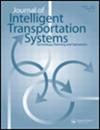准确检测车辆,行人,自行车和轮椅从路边的光检测和测距传感器
IF 2.8
3区 工程技术
Q3 TRANSPORTATION
Journal of Intelligent Transportation Systems
Pub Date : 2024-11-01
DOI:10.1080/15472450.2023.2243816
引用次数: 0
摘要
准确的检测对于改善弱势道路使用者的安全状况起着至关重要的作用。本研究将基于基础设施的激光雷达应用扩展到所有三个主要的弱势道路使用者群体,包括行人、骑自行车的人和轮椅使用者。精确检测小型道路使用者的两个关键问题是扫描角度的变化和特征的波动。为了解决这些问题,提出了一种结合LiDAR轨迹信息的基于特征的分类方法。提出了有效的维度相关特征,并采用一种新的特征工程过程对人工神经网络(ANN)、随机森林(RF)、自适应增强(AdaBoost)、随机欠采样增强(RUSBoost)和长短期记忆(LSTM)五种分类器进行了测试。从聚类的点云中共选择7个特征进行车辆/行人/骑自行车/轮椅分类。通过基于整个轨迹的先验信息更新这些重要特征,显著提高了道路使用者分类(不平衡数据集)的性能。实验研究了整合先验轨迹信息前后车辆、行人、自行车和轮椅的召回率、f1得分和AUC。结果显示了训练有素的演算法,RUSBoost LSTM分类器与以前的轨迹信息可以实现召回/ F1-score / AUC:(1)低流量——车辆(100% / 99.96% / 99.96%),行人(99.96% / 99.96% / 99.97%),骑自行车的人(99.74% / 99.45% / 99.67%),和轮椅(99.22% / 99.68% / 99.01%)和(2)温和的流量-车辆(99.39% / 99.44% / 99.69%),行人(98.33% / 97.99% / 98.64%),和骑自行车的人(95.41% / 94.29% / 94.40%),使用32-laser激光雷达传感器(10 Hz)。本文章由计算机程序翻译,如有差异,请以英文原文为准。
Accurate detection of vehicle, pedestrian, cyclist and wheelchair from roadside light detection and ranging sensors
Accurate detection plays a critical role in improving the safety situation of vulnerable road users. This study extends infrastructure-based LiDAR application to all three major vulnerable road user groups including pedestrians, cyclists, and wheelchair users. Two critical problems for accurate detection of small-sized road users are scanning angle variability and feature fluctuation. To address these issues, a feature-based classification method combined with prior LiDAR trajectory information is developed. Effective dimension-related features are proposed and five classifiers including artificial neural network (ANN), random forest (RF), adaptive boosting (AdaBoost), random under-sampling boosting (RUSBoost), and long short-term memory (LSTM) are tested with a novel feature engineering process. A total of seven features are selected from the point cloud of clusters for vehicle/pedestrian/cyclist/wheelchair classification. By updating these significant features based on prior information of the entire trajectory, the performance of road user classification (imbalanced datasets) has been significantly improved. Experimental study is conducted to examine the recall rate, F1-score, and AUC of vehicles, pedestrians, cyclists, and wheelchairs before and after integration with prior trajectory information. The result shows the trained AdaBoost, RUSBoost, and LSTM classifiers with prior trajectory information can achieve recall/F1-score/AUC: (1) Low traffic volumes – vehicles (100%/99.96%/99.96%), pedestrians (99.96%/99.96%/99.97%), cyclists (99.74%/99.45%/99.67%), and wheelchairs (99.22%/99.68%/99.01%) and (2) Moderate traffic volumes – vehicles (99.39%/99.44%/99.69%), pedestrians (98.33%/97.99%/98.64%), and cyclists (95.41%/94.29%/94.40%), using 32-laser LiDAR sensors (10 Hz).
求助全文
通过发布文献求助,成功后即可免费获取论文全文。
去求助
来源期刊
CiteScore
8.80
自引率
19.40%
发文量
51
审稿时长
15 months
期刊介绍:
The Journal of Intelligent Transportation Systems is devoted to scholarly research on the development, planning, management, operation and evaluation of intelligent transportation systems. Intelligent transportation systems are innovative solutions that address contemporary transportation problems. They are characterized by information, dynamic feedback and automation that allow people and goods to move efficiently. They encompass the full scope of information technologies used in transportation, including control, computation and communication, as well as the algorithms, databases, models and human interfaces. The emergence of these technologies as a new pathway for transportation is relatively new.
The Journal of Intelligent Transportation Systems is especially interested in research that leads to improved planning and operation of the transportation system through the application of new technologies. The journal is particularly interested in research that adds to the scientific understanding of the impacts that intelligent transportation systems can have on accessibility, congestion, pollution, safety, security, noise, and energy and resource consumption.
The journal is inter-disciplinary, and accepts work from fields of engineering, economics, planning, policy, business and management, as well as any other disciplines that contribute to the scientific understanding of intelligent transportation systems. The journal is also multi-modal, and accepts work on intelligent transportation for all forms of ground, air and water transportation. Example topics include the role of information systems in transportation, traffic flow and control, vehicle control, routing and scheduling, traveler response to dynamic information, planning for ITS innovations, evaluations of ITS field operational tests, ITS deployment experiences, automated highway systems, vehicle control systems, diffusion of ITS, and tools/software for analysis of ITS.

 求助内容:
求助内容: 应助结果提醒方式:
应助结果提醒方式:


